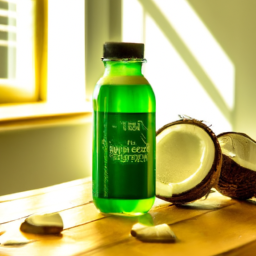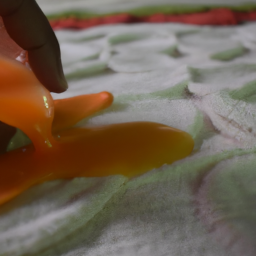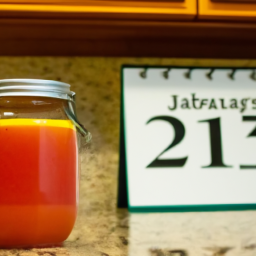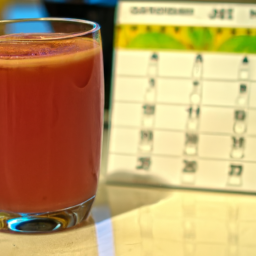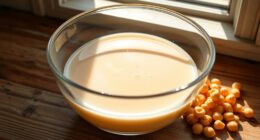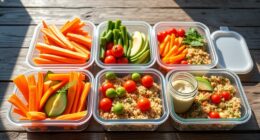While relaxing on my couch and sipping on some apple juice that I had forgotten about for a bit, I found myself wondering, “How long can apple juice safely sit out?”
While it may seem like a simple question, the answer is not as straightforward as one might think. Proper storage of apple juice is crucial for maintaining its freshness and avoiding spoilage. In this article, I will explore the shelf life of unopened and opened apple juice, signs of spoilage, alternative storage methods, health risks associated with spoiled juice, and tips for properly storing apple juice.
Many of us have experienced the unpleasant taste and smell of spoiled apple juice. But did you know that consuming spoiled juice can pose health risks? As a consumer, it is important to be aware of the shelf life of apple juice and the signs of spoilage in order to avoid potential health hazards.
Whether you are a parent packing juice boxes for your child’s lunch or simply a juice enthusiast, understanding the proper storage of apple juice can ensure that you are consuming a safe and refreshing beverage.
Let’s dive into the details of how long apple juice can be left out and the factors that affect its shelf life.
Key Takeaways
- Leaving apple juice out too long can cause growth of harmful bacteria
- Do not leave at room temperature for more than 2 hours
- Spoiled apple juice can be identified by funky odor and off taste
- Improper storage can lead to contamination and illness
The Importance of Proper Storage
You need to make sure you’re storing your apple juice properly, or you could end up with a nasty surprise. The first thing you need to consider is temperature control. Apple juice should be stored in a cool and dry place, away from direct sunlight and heat sources. This is because heat can promote the growth of bacteria and mold, which can spoil your juice.
The second thing to consider is the packaging materials. Apple juice should be stored in airtight containers to prevent exposure to air. Exposure to air can cause the juice to oxidize and lose its flavor and nutritional value. Additionally, you should avoid storing apple juice in containers made of certain materials, such as plastic, as they can release harmful chemicals into the juice.
With proper temperature control and packaging materials, you can ensure that your apple juice stays fresh for longer. Moving on to the shelf life of unopened apple juice, it’s important to know how long you can keep it before it goes bad.
Shelf Life of Unopened Apple Juice
When you bring home a carton of fresh apple juice, it’s best to consume it before the ‘best by’ date printed on the packaging. The shelf life of unopened apple juice can vary depending on the processing method and the storage conditions. According to the United States Department of Agriculture (USDA), unopened apple juice can last up to eight months when stored at a constant temperature of 40°F or below. However, this is just an estimate, and the actual shelf life can be affected by factors such as the type of container used and the storage conditions.
To help you understand the shelf life of unopened apple juice, here’s a table that outlines the estimated duration of different types of apple juice when stored properly:
| Type of Apple Juice | Shelf Life (Unopened) |
|---|---|
| Shelf-stable | 12 to 18 months |
| Refrigerated | 7 to 10 days |
| Frozen | 8 to 12 months |
It’s important to note that the expiration date on the apple juice packaging is just an estimate, and the actual shelf life can vary. It’s also important to keep in mind that apple juice fermentation can occur even before the expiration date, especially if the juice has been exposed to air or warm temperatures. In the next section, we’ll discuss the signs of spoilage to look out for in apple juice.
Signs of Spoilage
If your fresh apple juice has gone bad, you’ll be able to tell by the funky odor and the off taste. Apple juice can spoil due to a variety of factors, including common contaminants like bacteria, mold, and yeast. These contaminants can grow quickly in apple juice that has been left out for too long or stored improperly.
Additionally, discoloration issues may also arise as a result of spoilage, with the juice becoming darker or cloudy in appearance. To ensure that your apple juice remains fresh and safe for consumption, it’s important to store it properly and keep an eye out for signs of spoilage.
One way to prevent spoilage is to refrigerate your apple juice as soon as possible after opening it. This can help slow down the growth of contaminants and prolong the shelf life of the juice.
In the next section, we’ll take a closer look at the shelf life of opened apple juice and explore some tips for prolonging its freshness.
Shelf Life of Opened Apple Juice
When it comes to the shelf life of opened apple juice, there are a few key points to keep in mind. Firstly, the shelf life of apple juice is significantly shortened once it’s been opened. To ensure the longevity of your apple juice, refrigeration is a must.
Finally, it’s important to adhere to consumption guidelines to avoid any potential health risks associated with spoiled juice. As someone who regularly consumes apple juice, I find it important to stay informed on these factors to ensure I’m getting the most out of my juice.
Shortened Shelf Life
The shelf life of apple juice is shortened when it’s left out, isn’t it? As a virtual assistant, I’m programmed to tell you that the shelf life of canned apple juice is affected differently compared to homemade apple juice. Here are some reasons why:
- Oxygen exposure can cause the growth of bacteria and yeast, leading to spoilage.
- Temperature is important to prevent bacterial growth; apple juice should be stored between 32°F to 40°F.
- Light exposure can break down vitamins and nutrients, causing spoilage.
- Homemade apple juice has a higher sugar content than canned apple juice, which can cause fermentation and spoilage.
It’s important to follow refrigeration and consumption guidelines to ensure the safety and quality of apple juice.
Refrigeration and Consumption Guidelines
To keep your apple juice fresh and delicious, it’s important to refrigerate it and follow the recommended consumption guidelines. Proper refrigeration is crucial to maintaining the quality of your apple juice.
Unopened apple juice can last up to eight months in the fridge, while opened apple juice should be consumed within seven to ten days. Additionally, it’s important to always check the expiration date before consuming apple juice. Even if the expiration date hasn’t passed, if the apple juice has an off smell or taste, it’s best to discard it.
Always make sure to keep apple juice at or below 40°F (4°C) in the fridge to prevent the growth of bacteria. Following these guidelines will ensure the safe consumption of your apple juice.
When it comes to freezing apple juice, there are a few things to keep in mind. While it is possible to freeze apple juice, it’s important to note that the texture and flavor may be affected. If you do choose to freeze apple juice, make sure to leave some headspace in the container to allow for expansion, and consume it within six months for best quality.
Freezing Apple Juice
When it comes to freezing apple juice, there are both pros and cons to consider.
On the one hand, freezing can extend the shelf life of apple juice for up to 8 months, making it a convenient option for those who want to stock up.
On the other hand, freezing can alter the taste and texture of the juice, potentially making it less enjoyable to consume.
When thawing frozen apple juice, it’s important to follow proper guidelines to ensure safety and quality.
It’s recommended to thaw the juice in the refrigerator and consume it within 3-4 days of thawing.
Pros and Cons
Sipping on a chilled glass of apple juice is refreshing, but leaving it out for too long can have both benefits and drawbacks. On the one hand, allowing apple juice to sit at room temperature for a few hours can enhance its flavor and aroma. This is because the natural sugars in the juice become more concentrated as the liquid evaporates, resulting in a richer, sweeter taste. Additionally, leaving apple juice out can make it easier to use for other purposes, such as cooking or baking. For example, leftover apple juice can be used in marinades, salad dressings, and even homemade apple juice recipes.
On the other hand, there are some drawbacks to leaving apple juice out for too long. One of the most significant concerns is the growth of harmful bacteria, which can cause foodborne illnesses. This is especially true if the juice is left out for more than a few hours or if it is not stored properly. To help prevent this, it is essential to store apple juice in the refrigerator or freezer as soon as possible after opening. By doing so, you can ensure that your apple juice stays fresh and safe to consume. Speaking of consumption, let’s now move on to the next section, which covers thawing and consumption guidelines for frozen apple juice.
Thawing and Consumption Guidelines
If you want to enjoy your frozen apple juice, simply take it out of the freezer and let it thaw in the refrigerator overnight. Refreezing juice should be avoided as it can lead to a change in texture and flavor, and potentially harmful bacteria growth.
Once thawed, apple juice should be consumed within a week if kept in the refrigerator. It’s important to note that apple juice should not be left at room temperature for more than 2 hours as bacteria can quickly grow in this environment. If you accidentally leave your apple juice out, it’s best to discard it to avoid any potential illnesses.
If you’re looking for alternative storage methods, consider freezing the apple juice in ice cube trays for easy portioning or investing in a vacuum sealer to extend the shelf life.
Alternative Storage Methods
You don’t have to keep your apple juice in the refrigerator like a delicate flower, but you should store it in a cool, dark place to preserve its freshness. Vacuum sealing and canning are two alternative storage methods that can extend the shelf life of apple juice. Vacuum sealing involves removing all the air from the container to prevent oxidation and microbial growth. This method can prolong the juice’s freshness for up to a year. Canning, on the other hand, involves heating the juice to kill any microorganisms and sealing it in airtight jars. This method can preserve the juice’s quality for up to two years.
In addition to vacuum sealing and canning, there are other ways to extend the shelf life of apple juice. One such method is adding preservatives. However, if you prefer natural apple juice without any additives, you can freeze it. Freezing can extend the shelf life of apple juice for up to eight months. But, be careful not to leave it out for too long after thawing as it can create ideal conditions for bacteria growth. Always check the juice’s appearance, smell, and taste before drinking it, as consuming spoiled apple juice can pose health risks such as food poisoning.
Health Risks Associated with Spoiled Apple Juice
Now that we’ve discussed alternative storage methods for apple juice, let’s talk about the potential health risks associated with spoiled apple juice. It’s important to understand that improper storage can lead to contamination, which can cause illness.
Here are some common bacteria types that can be found in spoiled apple juice:
- Escherichia coli (E. coli)
- Salmonella
- Listeria
- Campylobacter
- Clostridium botulinum
These bacteria can cause a range of symptoms such as nausea, vomiting, diarrhea, fever, and even death in severe cases.
To prevent contamination, it’s important to follow proper storage guidelines. This includes keeping the juice refrigerated at all times, even before it’s opened, and ensuring that the container is properly sealed to prevent air and bacteria from getting in.
It’s crucial to understand the potential risks of consuming spoiled apple juice and take the necessary precautions to prevent contamination.
In the next section, we’ll discuss some tips for properly storing apple juice to ensure it stays fresh and safe to consume.
Tips for Properly Storing Apple Juice
Properly storing apple juice can ensure its freshness and safety for consumption, so let’s explore some helpful tips.
Firstly, it’s important to choose the best containers for storing apple juice. Glass or plastic bottles with tight-fitting lids are the best options, as they prevent air and light from entering the container, which can cause spoilage.
Additionally, it’s recommended to store apple juice in small containers rather than one large container. This reduces the amount of air that comes into contact with the juice and can extend its shelf life.
Another important factor to consider when storing apple juice is the temperature. Apple juice should be stored at room temperature, which is around 68-72°F (20-22°C). It shouldn’t be stored in direct sunlight or near heat sources, such as stoves or ovens.
When refrigerating apple juice, it’s important to keep it at a consistent temperature and not to freeze it, as this can cause the juice to spoil.
By following these tips, you can help extend the shelf life of your apple juice and ensure its freshness and safety for consumption.
It’s important to note that there are other factors that can affect the shelf life of apple juice, such as the quality of the juice, the processing method, and the presence of preservatives. These factors should also be taken into consideration when storing apple juice to ensure its freshness and safety for consumption.
Other Factors That Affect Shelf Life
To extend the shelf life of your freshly squeezed juice, it’s important to consider the impact of pH levels. Juices with lower pH levels have a longer shelf life due to their ability to resist spoilage caused by bacteria and fungi. This is because the acidic environment created by the low pH levels inhibits the growth of microorganisms.
On the other hand, juices with higher pH levels are more susceptible to spoilage and should be consumed within a shorter time frame.
Other factors that affect the shelf life of apple juice include storage temperature and packaging material. It’s recommended to store apple juice at a temperature between 34-40°F to preserve its freshness. Additionally, the packaging material used for storing apple juice should be airtight and resistant to light and air exposure.
This is because exposure to light and air can cause oxidation and spoilage, which can shorten the shelf life of apple juice. By considering these factors, you can extend the shelf life of your apple juice and enjoy its delicious taste for a longer time.
Frequently Asked Questions
How many days can apple juice be left out before it spoils?
The shelf life of apple juice can vary depending on storage conditions. To determine spoilage, check for changes in smell, taste, and appearance. It is recommended to refrigerate apple juice immediately after opening and consume within 7-10 days.
Can apple juice still be consumed if it has been left out overnight?
Consuming apple juice left out overnight is not recommended due to potential hazards like bacterial growth. Best storage practices involve refrigerating apple juice immediately after opening and discarding it if left at room temperature for more than two hours.
Is it safe to drink apple juice that has a slightly fermented smell?
Drinking apple juice with a slightly fermented smell can pose potential health risks as the fermentation process can lead to the growth of harmful bacteria. It is recommended to discard any juice with an off odor or taste.
Can apple juice be stored in the pantry instead of the refrigerator?
Yes, apple juice can be stored in the pantry. However, it has a shorter shelf life compared to refrigerated juice. Pantry storage options should be limited to a few days, while refrigerated juice can last up to a month.
How long can apple juice be stored in a plastic bottle compared to a glass bottle?
In my experience, plastic bottles are better for storing apple juice than glass bottles. However, taste comparison between apple juice from concentrate and freshly squeezed is subjective. It is important to refrigerate juice promptly after opening to maintain freshness.
Conclusion
In conclusion, proper storage of apple juice is crucial to ensure its safe consumption. Leaving it out for too long can lead to spoilage and potential health risks.
The shelf life of unopened apple juice is relatively long, but once opened, it must be consumed within a few days or frozen. Freezing apple juice is an effective way to extend its shelf life, but alternative storage methods such as using airtight containers can also be employed.
It may seem trivial, but taking the necessary steps to properly store apple juice can make a significant difference in one’s health and well-being. Don’t underestimate the power of a simple glass of apple juice, as it can provide numerous health benefits.
With this knowledge in mind, be sure to carefully store your apple juice and enjoy its refreshing taste and nutritional benefits for as long as possible.
Ilana has been a vegan for over 10 years. She originally made the switch for health reasons, but soon found herself becoming more and more passionate about the ethical and environmental implications of a vegan lifestyle. Ilana is the author of The Graceful Kitchen, a blog all about veganism. She loves to cook up delicious and nutritious vegan meals, and share her recipes with others who are interested in leading a cruelty-free life. Ilana is also a strong advocate for using whole foods as the foundation of a healthy diet, and believes that going vegan is one of the best ways to achieve this.

